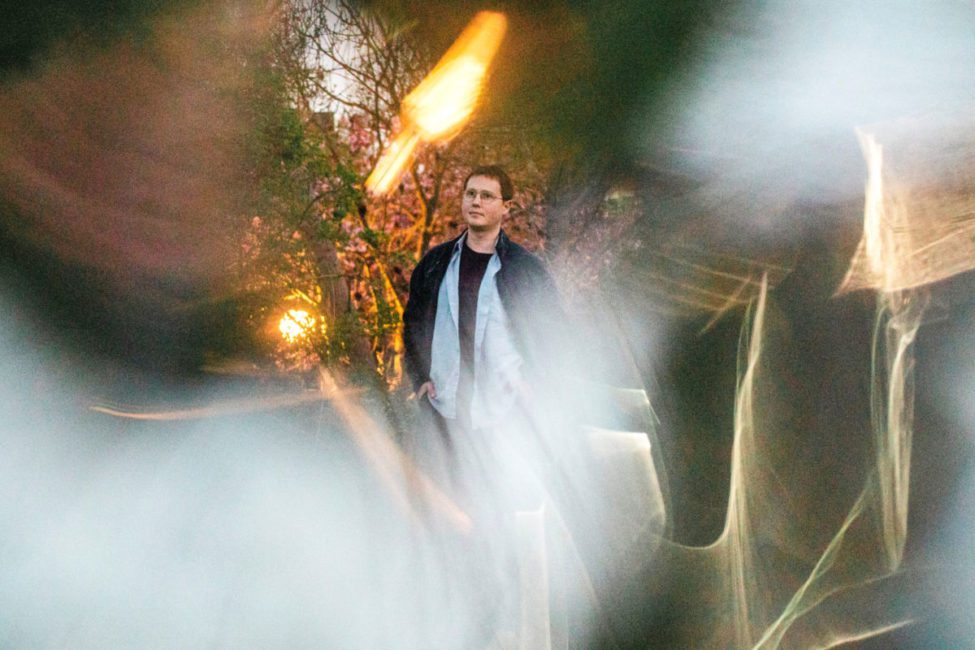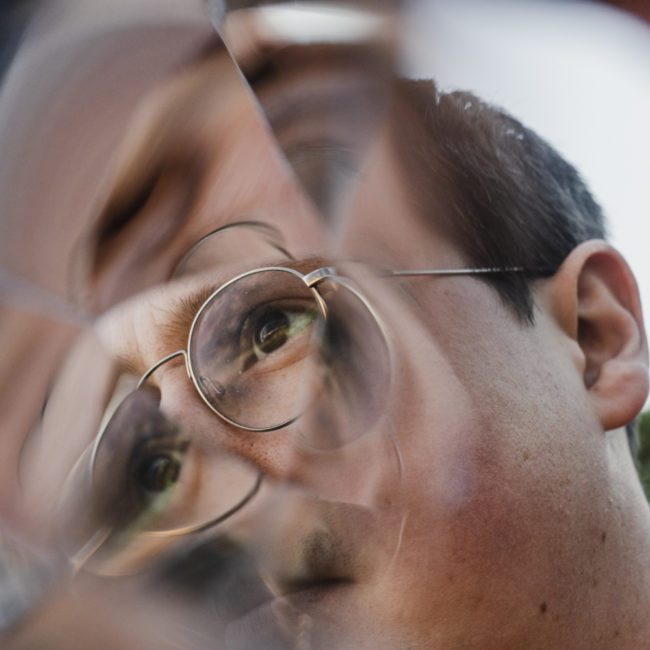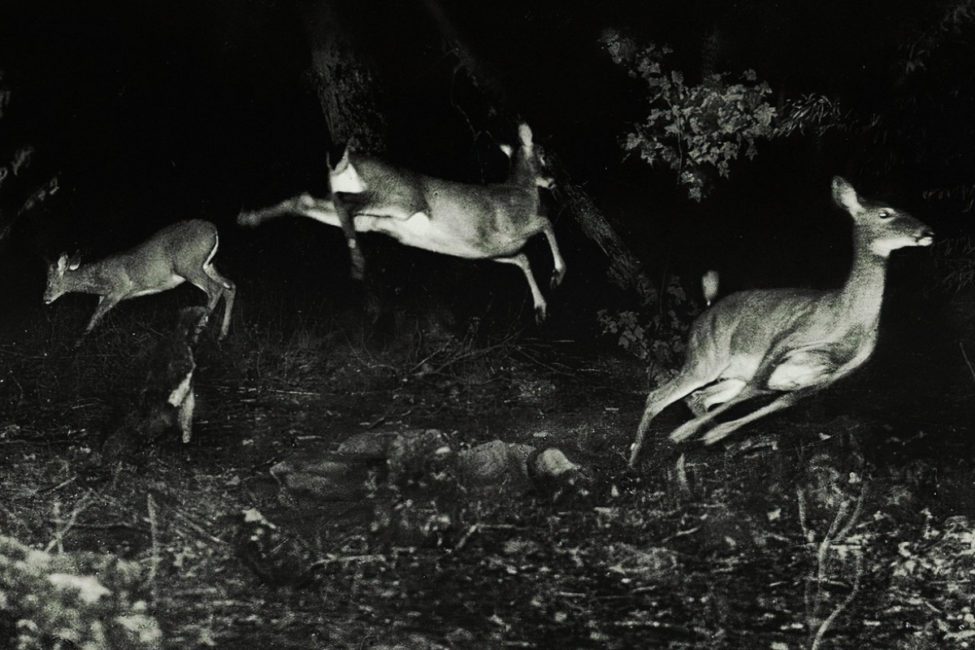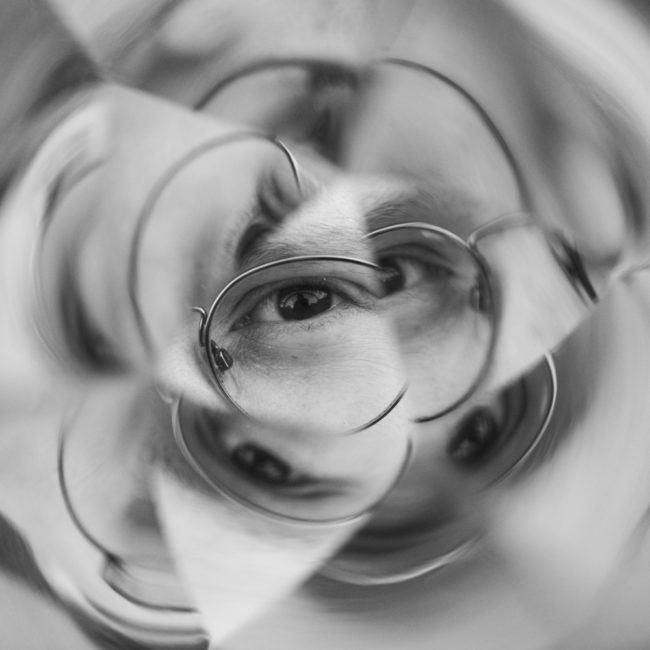When we first heard Wordcolour‘s music released through Houndstooth, our ears picked up: here was a producer clearly as equally fascinated by sound and inter-sonic relationships that go far beyond simply making people dance — as adeptly as they were capable of doing so, on early EP ‘Juno Way‘ and the subsequent ‘Bluster‘ single.
Even still, what we had to hear of Wordcolour’s dancier tendencies — take ‘Bluster‘, for example — took a generally sedate pace, allowing the moments of synchronicity and detail to shine forth. After the release of a full-length release, ‘The trees were buzzing, and the grass.‘, our working definition of the London-based producer had to change drastically.
Opening with a single disembodied word, “Loom”, ”The trees were buzzing…’ envelopes the listener into a world where relationships between entities and objects are displaced, with all present notions of sound offered as equal importance. Merging moments of fractional sound with long, sustained notes together requires a more far-sighted vision than the composition of a single piece, and throughout the album it’s often that the music feels self-referential to other compositions in the collection.
The resulting experience is unlike one we’ve had the fortune of listening to with any stable regularity: Wordcolour has built a world as instantly gratifying in quiet moments (‘Duet‘, ‘I am sixty years old and trying salvia for the first time‘) as it is in the breakneck shivers of “clubbier” tracks like ‘Babble‘ that give us more than a passing reminiscence to ‘floor music played by the likes of Djrum.
Rarer still is the sense of cohesiveness to the album. There are no outlier tracks, no cast-offs reunited, no extra WIPs that have found a home: instead, the body of work is complete, perhaps a reflection of a single collection of moods and moments, but entirely in ownership of itself, and the listener who tunes into the message.
One month post-release, we are thankful to have been offered an audience with the producer to attempt to uncover some of the more beguiling secrets on ”The trees were buzzing…’, hoping to find the source of the magic threads that run through the album, cementing its quality.
We discuss the usage and significant of the disembodied voices circling the album, what relevance the term “ambient” music actually offers in today’s musical environment, and the artist’s plays with the concept of narrative, in an interview that turns a floodlamp to the opaque corners of the album.
Interview by Freddie Hudson
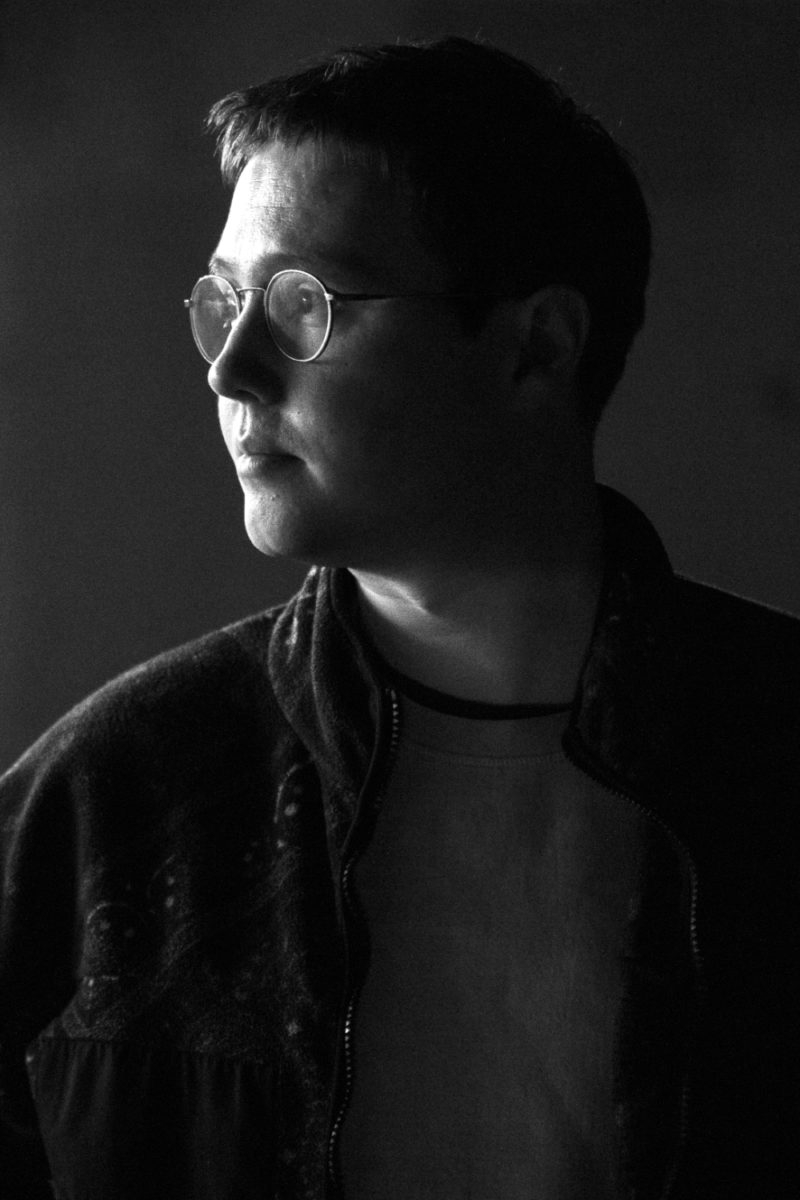
"When I work with voices I think what I’m mostly interested in is emotional tone, more than the content of what is being said"
Before we begin, I’d like to congratulate and thank you on the release of your album. It demonstrates a huge leap forward from your already intriguing output on Houndstooth, ‘Juno Way’ and ‘Bluster’. One very dominant aspect which is different to the rest is the (seemingly) random content of the spoken word sections. Can you give us some information about the creative impulse behind this, and the use of spoken word in general?
Thank you so much!
Hmm, so I think a fascination with the sound of the spoken voice is something I’ve carried with me since the very start of Wordcolour. And when I work with voices I think what I’m mostly interested in is emotional tone, more than the content of what is being said.
We instinctively respond to the way someone says something, even in another language. We have an empathetic reaction that to me seems hard-wired… e.g. if we walk into a room to find people we know laughing, we find ourselves laughing too, even as we say “so what’s so funny?”.
The longer-form spoken samples on the record were ones that I found really compelling because they are voices which are emotionally charged in some way. Each is a person in a moment of vivid personal experience, revealing a lot about themselves in the way they say what they say. I was interested in trying to capture the expressive potential of these voices, exploring what I can pair them with, and how it feels to listen to them.
In contrast to these samples, there’s also this list of words (written in collaboration with my friend Es Morgan) which I recorded a few different people reading. I asked everyone to deliver them like an optician giving an eye test, so they are much less emotional – they have a kind of BBC instructional feel. I wanted to use them to help hint at narratives, and sketch out an imagined environment in which the album takes place. If the longer samples are characters then these are the narration.
In your first Houndstooth EP, ‘Juno Way’, the ‘Juno’ track begins with a single “yes”, with other voices joining to add their agreement or consent throughout the track. Was this a seedling, from which this album has grown?
Ah interesting, do you know I’d never made that connection! But I think maybe that track, and then some of the voices on my first EP, are probably both part of me getting a feel for a way of working which I expanded on the LP.
The spoken word passages are, for me, the most unique or engaging aspects of the album as a whole, tying together the ambient and the dancefloor material with something which seems to tell a story, and at the very least create a lasting narrative language within your music. This “narrative” is something I often see missing from many electronic albums, particularly from those typically producing functional gear. I’d like to ask about your process of developing this language for yourself on this album.
I think the record constantly plays with having the ‘feel’ of narrative, without actually having one at all. There’s no story. But I did try to create a palpable world and a strong sense of place at several points on the record, or to reference certain things (e.g. there’s one track that maybe just stops short of describing a UFO sighting…). But it’s all about creating a feeling – my guiding force is always my gut. I don’t think I’m very cerebral about this stuff when I’m making it.
I don’t think I would ever do something which had a more linear story (probably something that’s very very hard to do well), but I think maybe where this feeling of narrative on the album comes from is me borrowing the sonic aesthetics of film or radio drama. Stuff where we are used to there being narrative. So it’s like the aesthetics of story-telling without the actual story.
There’s a nice sentence on the Bandcamp page for the release, describing the “cinematic” quality of the album veering and cutting between shots like a film. It’s certainly noticeable on listening, with different tracks launching the listener in different directions. First, I’d like to ask a bit about why you are developing your composition into this style, whereas the previous material demonstrated perhaps longer-stretching grooves?
Hmm, I think maybe I don’t quite agree there about my older stuff. I feel like tracks like ‘Kicking & Screaming‘, ‘Breathless‘, ‘Bluster‘ are all pretty choppy and changey. Whereas tracks like ‘people can you hear me?‘ or ‘Nonet’ from the album feels quite flowy to me. But it’s true there is a lot of this jump-cutting elsewhere on the record.
I think that I just enjoy it when I hear stuff that does this! I like music that’s a step or two ahead of me when I hear it, so I’m always trying to be a step ahead of my listeners. I think surprise in music is really fun. But also, for me, one of the real joys of sample-based music is that we can switch audio environments at will, and combine sounds from the real world that don’t belong together at all. It’s like a magic trick, and I think you can create something extremely vivid in the mind of the listener.
I’m curious about how you see or saw this approach going down amongst your established listeners? It’s not jarring at all, but it does mark a very different movement in your sound, in my eyes.
That’s a very good question. I think the whole time I was making the album (and even now) I was quite concerned about how it would be received. It took me about a year to write, and then there was a further 6 month wait for the vinyl to be pressed etc, so this meant having quite a long gap in releases after only a couple of EPs.
I think my concern was that this album falls between genres too much and might just baffle anyone that had been into my stuff before. There’s no club hit, no obvious single. The ambient tracks are too narrative to be playlist-able as ambient music etc.
I think in my more cynical moments I became convinced I was making a record for a listening context that doesn’t really exist any more. Like…I kind of imagined people getting a bit buzzed, lighting some candles, putting the vinyl on and lying on the floor for the whole thing. Like it’s fucking ‘Dark Side of the Moon‘ or something. But that’s not how people listen to music any more really…I know I rarely do. But it was the idea of making a whole world and a whole journey that really inspired me to make it. I’ve had friends tell me that this is how they heard it and that always makes me extremely happy.
For you, what is the biggest leap in your composition and production for this album?
Apart from the fact that I’m always learning and improving as a producer on a technical level, I think there was some structural stuff about making a longer record. As soon as I decided to make an album I made two decisions straight away. One was that I didn’t have to see myself as a club producer on this record, and I could explore lots of territory that interests me that maybe falls outside of that.
The other was that any more club-ish tracks would be written for listening and not DJing. So intros and outros are all about flow from the previous track, rather than having a few bars of hi-hats for beat matching etc. There’s also one track that’s in a very quick 9/8… stuff like this. So it was more giving myself permission to explore a bunch of stuff that I hadn’t done on the club EPs.
To me at least, there seems to be an interesting duality to the album. On the one hand, the “dancefloor” material seems to be more complex, and geared more towards faster and more experimental floors than before, but conversely, the “ambient” material is certainly more prevalent. Do you agree with this rough analysis?
Yeah that’s fair, certainly on the ambient side which I’d only really explored in mixes before. The dancefloor stuff… I think in general I’ve been into faster stuff the last few years, and I definitely find that 160+ is my favourite zone when DJing.
The thing I love about these tempos is the fast/slow half time/double time thing where there are so many ways to feel the pulse and find your way through the music. I love that as a dancer too, and it’s lots of fun to play with as a producer.
I think the experimental thing comes from what I was saying before about not really writing for DJs on this record… I find when you stop thinking about how something might be mixed it opens up all sorts of possibilities.
"One of the real joys of sample-based music is that we can switch audio environments at will, and combine sounds from the real world that don't belong together at all. It's like a magic trick, and I think you can create something extremely vivid in the mind of the listener"
Why are you channeling these two threads in this manner? Do you see them as separate in the first place?
I’d love to say that I don’t and it’s all just a big spectrum. And whilst there is lots of music where the lines between ambient and club start to feel quite blurred, I think personally I find these two types of track very different to make and I think I’m trying to achieve different things with them when I do.
I think the reason I was channeling them in this way is because up until then there had been two quite separate sides to Wordcolour – the spoken word and ambience of stuff like my Blowing Up The Workshop mix, and then the club EPs. Doing an album seemed like a good opportunity to find the links and try and create some kind of unified whole.
I don’t see you as a solitary figure in divining experimental dance music and ambient music as two halves of the same whole. Certainly, Djrum’s remix on your ‘Bluster’ EP (alongside his other work) mines the same vein, and the album track ‘Babble’ for me reflects as a rare example of music similar to his that doesn’t come off as a copycat. Who else do you look up to for production inspiration in this field?
Oh well thank you! That’s a big compliment on ‘Babble‘. And I absolutely loved the remix that Djrum did.
This question is easy as there are two artists that have had such an impact on me in terms of ways to conceptualise the whole ‘club-not-club’ thing and that’s Objekt and Aya. I’m thinking specifically of ‘Cocoon Crush‘ and ‘im hole‘. Both are quite different to what I do, but both have such a singular world-building vision taking club aesthetics as a starting point, or framing device, and seeing where they can lead. As a producer I’m also totally in awe of them both on a technical level.
Actually, ‘im hole‘ came out on the day I got the masters of my album back and I listened to them both back to back on headphones, and production-wise her album is just stunning. I found it pretty intimidating to accidentally compare the two like that! But this is the stuff that pushes you forward.
I believe that there is more and more unspoken demand for “ambient” music within live electronic music events, as people wean themselves back from Pandemic living and struggle to relate in the club. Do you also agree? Is this album something of a statement in that regard?
I guess the first thing to say is that I actually really hate the term “ambient” because I don’t think it adequately describes a lot of music that falls in this genre. I definitely don’t think it’s quite right for those tracks on my album as I don’t think they work particularly well as functional background music. But I also hate the term “experimental” so I’m constantly struggling to find the right word to describe this side of what I do.
But yes, I do think there is an increased appetite for this stuff live. I think festivals like Berlin Atonal or Unsound make a strong case for how compelling this music can be when produced on a large scale with high production values and I do think there’s a growing audience for this.
My album isn’t intended as any kind of statement though, I just made what I wanted to hear. It’s more likely a result of being written during lockdown at a time when I was struggling to relate to much club music. So I made an album for how I was listening to music at the time, which was on headphones.
Continuing this trail of thought, I imagine you’re preparing and performing live and/or DJ sets in relation to the launch of your album. Do you approach these with the balance of calm and energetic in mind? Or do your recent performances lean towards one or the other?
I guess I see the two as very separate, and my live sets and my DJ sets are quite different. I’ve recently put together a live set in tandem with the new record, and this leans heavily into the more ambient (that word again!) side of the record. It’s this big woozy psychedelic journey with lots of spoken word and amazing trippy visuals from my friend Andrea Khora.
Whereas my DJ sets are dancefloor focussed. They are about my dialogue with, and love of, DJing and club music. I love DJ sets which take you on a journey, and I like twists and turns, but my sets are still aimed at the floor.
Lastly, I wanted to ask you about the apparent recent revival of breakbeat and jungle-influenced tracks in the current musical zeitgeist. I’ve noticed a lot of DJ’s making and playing music in these rough genre zones lately, where previously this music wasn’t heard in their sets/productions, and I wonder whether this is the latest trend. Have you noticed this, or do you disagree? [Can you offer any thoughts as to why this might be?]
Yeah good question. I’ve definitely noticed a trend towards faster tempos in the last few years (and also slower ones actually!). I wonder whether it has something to do with the rise of the eclectic 160/170 DJ set.
Those sets that fuse Jungle and Footwork and fast Electro and half-time 85bpm stuff and IDM etc etc. I love playing like this and I think hearing these kinds of blends maybe points towards new creative possibilities for producers.
But I can’t really speak too much for anyone other than myself, and for me there’s another side to this which is the focus my music has on sampling and cutting up sound. On a conceptual level, I’m interested in trying to explore the sonic links between disparate sampling cultures: between Jungle and Musique Concrète for example. To me there’s a common ingenuity, joy, and sense of play between Delia Derbyshire or 4hero beavering away in the studio – a kind of “Let’s cut this up and see what we can make”.
‘The trees were buzzing, and the grass’ is out now via Houndstooth. Order a copy from Bandcamp.
Photography by Jemima Yong
TRACKLIST
1. (loom)
2. Blossom
3. Cloud Room
4. Duet 02:42
5. I am sixty years old and trying salvia for the first time
6. Babble
7. Crescent
8. people can you hear me?
9. Nonet
10. (drift)
